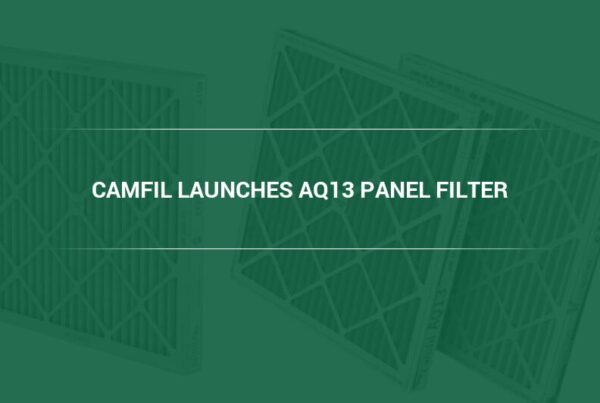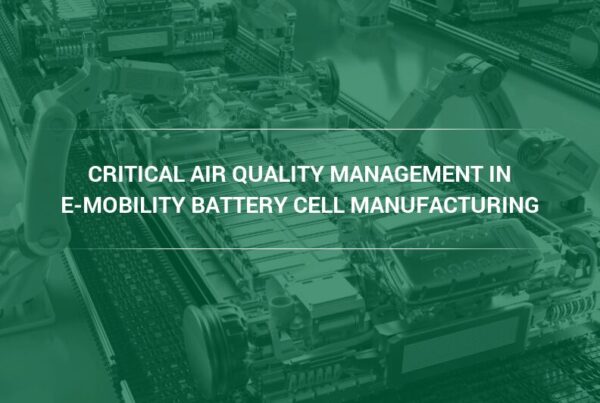Maintaining indoor air quality (IAQ) is as critical as ensuring clean outdoor air, as both impact the health, safety and comfort of millions. While global efforts focus on outdoor air quality, it is essential for schools, manufacturers, healthcare institutions, biotech companies and commercial building owners to take responsibility for the IAQ within their facilities. Air filters play a crucial role in achieving high IAQ by capturing various contaminants present in indoor environments.
Indoor air pollutants originate from multiple sources, including particulate matter, chemicals from cleaning products and pesticides, off-gassing from building materials, germs, bacteria and outdoor air pollution. Sensitive industries, such as life sciences, face unique contaminants and risks that can affect worker health and research outcomes.
The Environmental Protection Agency (EPA) identifies IAQ as one of the top five most urgent environmental risks to public health. In the short term, poor IAQ can cause headaches and eye irritations and exacerbate existing conditions such as asthma. Long-term exposure to air contaminants can even result in lung and heart disease.
The Occupational Safety and Health Act of 1970 requires companies to provide a place of employment free from recognized hazards that can harm employees. It also lists regulated air contaminants. By using Camfil air filters, companies can seek to comply with permissible exposure limits (PELs) by capturing contaminated air particulates and fumes before they enter the working environment.
Challenges Faced by Life Science Labs
The Occupational Safety and Health Administration (OSHA) estimates that more than half a million workers are employed in labs across the United States. Lab environments can be hazardous, with chemicals and equipment generating particulate matter, trace elements, inorganic gases and volatile organic compounds (VOCs) that negatively impact IAQ.
- Particulate Matter: Sources of particulate matter in labs include Bunsen burners and powders used in experiments. Smaller particulates pose a higher danger to human health. For instance, ultrafine particles measuring less than 0.1 micrometers can penetrate deeply into the respiratory system and heart, causing severe health issues.
- Trace Elements: Metals and biologics can be released into the atmosphere from solid materials, powders and chemicals used during research. Inorganic gases such as sulfur dioxide (SO2) and carbon dioxide (CO2) can be produced by specific equipment and compounding processes.
- VOCs: VOCs in labs come from solvents, cleaning agents and chemical agents. These can emit gases into the environment due to bottle leakage, spills, evaporation from open sources and mixing processes. Because of their potential health hazards, VOCs are regulated by the EPA under the National Volatile Organic Compound Emission Standards for Consumer and Commercial Products.
- Other Contaminants: Additional sources of contaminants in labs include water and ultrasonic baths, organic wastes, deionized or ultrapure water systems, unsterilized equipment, sample oven drying, bioaerosols and germs from staff.
Regulatory Standards and Guidelines
Laboratories must adhere to local, state and federal regulations. Organizations such as ASHRAE, OSHA and the EPA outline rules and guidelines to improve laboratory safety for workers.
As part of its Lab Standard, OSHA has established permissible exposure limits that specify the amount and duration that workers can be exposed to various hazardous and chemical substances. These PELs are crucial for evaluating labs and implementing adequate control measures such as industrial filters, to meet acceptable levels of exposure. OSHA also provides a webpage that offers current information on lab safety for lab and facility managers.
ASHRAE Standard 62.1 is the recognized standard for Ventilation and Acceptable Indoor Air Quality for commercial and institutional buildings. Revised in 2022, it now extends beyond basic ventilation requirements to recognize the importance of equipment, filtration, and controls in achieving comprehensive air quality. This standard plays a vital role in maintaining acceptable air quality levels in both new and existing buildings.
As part of its pollution prevention initiative, the EPA addresses various environmental topics including IAQ and ways to reduce exposure to VOCs. The EPA also initiated the Clean Air in Buildings Challenge to help facility managers and building operators improve IAQ. The Challenge includes a set of best practices to help reduce risks from airborne contaminants.
Air Quality Improvement Tactics
The Clean Air in Buildings Challenge outlines several key action items to optimize fresh air ventilation and enhance air filtration. These tactics include:
- Local Exhaust Ventilation (LEV)
LEV systems remove pollutants at their source before they can spread into a building’s indoor air. These systems collect hazardous fumes and particles at their point of origin and safely exhaust them, minimizing health risks for employees.
- HVAC Systems
In addition to regulating indoor climates, HVAC systems improve air quality by ventilating air. They exchange or replace air in a specific space, diluting or removing indoor pollutants. It’s important to determine the required amount of clean air (outdoor air plus filtered HVAC recirculated air) for a space and ensure that the outdoor air is clean or filtered before it enters the building.
- Air Filtration
Air filters are an integral component of HVAC systems, trapping and removing airborne particles to prevent pollutants from circulating into the environment. Using the correct filter significantly reduces the number of harmful particles in the air. For example, MERV 13 air filters or higher can capture various airborne particulates with high efficiency. Air filters rated a minimum of MERV 13/13A installed in HVAC systems capture an average of 85 percent of particles 1 micron and larger and 50 percent of particles larger than 0.3 microns. A MERV 14/14A filter eliminates an average of 75 percent of particles larger than 0.3 microns, while a MERV 16/16A filter targets 95 percent removal of particles larger than 0.3 microns.
Labs typically use high-efficiency particulate air (HEPA) filters that remove a minimum of 99.97% of airborne particles larger than 0.3 microns. (See Types of Air Filtration.)
- Air Cleaners
Air cleaners supplement HVAC system ventilation and filtration for specific applications or areas that are difficult to ventilate. However, air cleaners alone cannot ensure adequate air quality for some pollutant sources.
In the life sciences industry, high-efficiency air cleaners can help control contaminants that affect product, lab researchers and processes. Camfil offers a line of standalone industrial air cleaners in fit-for-purpose designs. These include the CamCleaner air cleaners that use certified HEPA and molecular filtration to remove dust particles, odors and gases.
Air Filtration Solutions for Different Labs
In the life sciences industry, laboratories have specific air quality requirements to ensure the safety of staff, equipment, processes and products. Air filtration is essential for eliminating odors, gases and air particulates, maintaining the strict cleanliness levels necessary for the research and development of vaccines, new drugs and therapies.
Outlined below are different air filtration solutions used by labs to address specific requirements.
- Formaldehyde Odor: The odor of formaldehyde is a significant issue in labs, causing headaches for staff who inhale this compound. Air cleaners equipped with absolute HEPA filters and molecular filtration efficiently address formaldehyde and other VOCs, effectively removing lab odors. These air cleaners offer a plug-and-play solution and are adaptable for different applications around the lab.
- In Vitro Fertilization (IVF) laboratories: These labs require a high level of process cleanliness and air quality. Airborne pollutants can dissolve in aqueous solutions of embryo culture mediums that cannot protect themselves. Studies show a direct relationship between clean air and procedural success. Removing airborne particles and gaseous contaminants can improve in vitro fertility rates.
In these situations, general ventilation air filters are insufficient for stringent molecular air quality control. HEPA filters, which efficiently capture particles as small as 0.3 microns, create a cleaner culture environment for embryo development. A filtration system comprising HEPA and broad-spectrum, targeted molecular media ensures the removal of these contaminants.
For even higher filtration, ultra-low penetration air (ULPA) filters can collect particles down to 0.12 microns in size. They are commonly used in creating a cleanroom environment for specific applications, though they are costlier both in purchase price and operational cost.
- Biosafety Labs: Researchers in these labs study infectious agents, bacteria, viruses, parasites and toxic substances can pose a serious threat if uncollected particles or gas molecules enter the air. An air filtration system that captures all potentially harmful airborne pathogens is imperative to protect workers and the environment from highly dangerous biological and chemical risks.
Filtration depends on the biosafety level of the lab. There are four biosafety levels, with BSL-4 indicating labs that can handle agents causing severe or even fatal untreatable diseases. Many BSL-4 labs around the world rely on air quality solutions to attain the highest level of safety. Camfil offers high-capacity filters with efficiency options up to 99.9995%, along with safe-change housings that prevent hazardous airborne materials from escaping into the environment.
- Cleanrooms: Many labs require cleanrooms that offer the highest level of cleanliness by filtering out microscopic pollutants such as airborne particles and microbes. This is to protect critical processes and personnel and prevent the escape of hazardous compounds. ISO 14644 specifies different classifications of air cleanliness based on airborne particle concentration in cleanrooms and clean zones.
High-quality filtration systems with HEPA-grade filters ensure regulatory compliance and maintain efficient operations. For cleanroom applications, Camfil offers HEPA/ULPA panel filters for installation in clean room ceiling modules or filter housings. These filters provide 95% efficiency in capturing particles up to 0.3 microns in size and up to 99.99995% for most penetrating particle sizes.
As part of a total air filtration system, Camfil also offers panel filters that serve as prefilters to protect and extend the life of valuable final filters. Implemented during the initial stage of filtration, they capture larger particles to protect primary HEPA filters. High-capacity and high-efficiency air filters serve as final filters in multi-stage units supplying air areas not requiring HEPA filtration.
IAQ is a priority in laboratories as it impacts worker health and research quality. Facility personnel and lab managers should work together to conduct an IAQ assessment to identify problems and sources of contaminants in creating a plan that sets goals and objectives for making upgrades and changes that improve IAQ.
Camfil can assist in this journey by visiting facilities and determining the right filtration system for a specific lab facility. We have the real-world expertise and breadth of products to provide thoroughly tested and energy-efficient particulate and molecular air filtration solutions for the life sciences industry. As new regulations and lab requirements emerge within the life sciences, Camfil keeps pace with new technology that ensures efficient air filtration for the highest IAQ.
To learn more about air filtration solutions for laboratories or to discuss specific air filtration needs and challenges, please contact Camfil today for a consultation.
¹https://www.osha.gov/sites/default/files/publications/3430indoor-air-quality-sm.pdf
²https://www.osha.gov/sites/default/files/publications/3430indoor-air-quality-sm.pdf
³https://www.osha.gov/annotated-pels/table-z-3
⁵T. Ugranli, E. Gungormus, A. Sofuoglu and S.C. Sofuoglu, Izmir Institute of Technology, Izmir, Turkey. Indoor Air Quality in Chemical Laboratories, Chapter 32, https://core.ac.uk/download/pdf/324142244.pdf
⁶https://www.osha.gov/laws-regs/regulations/standardnumber/1910/1910.1450
⁷https://www.osha.gov/laboratories
⁸https://www.ashrae.org/news/hvacrindustry/updated-standard-62-1
⁹https://www.epa.gov/indoor-air-quality-iaq/clean-air-buildings-challenge
¹⁰https://www.epa.gov/system/files/documents/2022-03/508-cleanairbuildings_factsheet_v5_508.pdf



